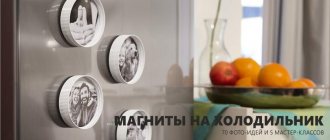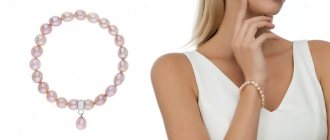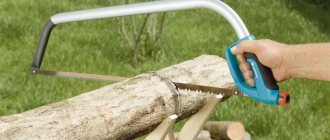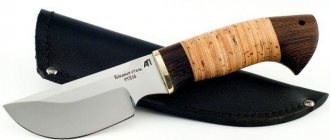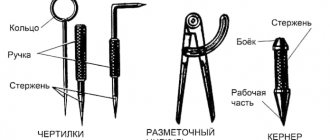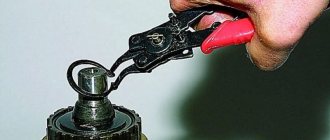History of the compass
We all used compasses at school in geometry and drawing lessons to draw circles and arcs. As a rule, compasses are made of metal. It consists of two “legs” of equal length, at the end of one of them there is a needle, and the other – a stylus.
There are also compasses with one leg with a needle at the end, and the second is a pencil. However, compasses are used not only for drawing circles, but also for measuring distances, for example on maps. In this case, use a compass with needles at the ends, without a stylus.
The Latin word "circulus" means "circle, circle." The word “compass” probably came into the Russian language through the Polish or German languages - from the words “cyrkul” or “Zirkel”.
We can say quite confidently that compasses, as well as rulers, were used in ancient times, about three thousand years ago. This is evidenced by buildings and images in Ancient Babylon and Assyria. Lines and circles have such regular shapes that they could hardly be made without these tools.
The history of the compass began several thousand years ago. Legends and myths of Ancient Greece tell us that this device was invented by Talos, the nephew of Daedalus. Talos invented a device that allows you to draw an absolutely perfect circle by connecting two rods of equal length. It can be assumed that Talos inherited a penchant for invention from his uncle. After all, according to legend, it was Daedalus and his son Icarus who flew into the sky with the help of the wings they invented.
During excavations of an ancient mound in France, archaeologists found a compass that is about two thousand years old. The age of bronze compasses found during archaeological excavations of the ancient Greek city of Pompeii is slightly younger. Their age is about 1900 years.
Throughout the history of compasses, several types of compasses have appeared:
- circular (drawing) – for drawing circles with a diameter from 2 to 80 mm;
- proportional – designed to change the scale of linear size;
- dividing (marking) – allows you to measure linear dimensions.
Few people know that compasses are widely used not only in cartography and drawing, but also in medicine. Doctors use compasses to measure the skull, hips and other parts of the human body. To do this, they use thick compasses - large and small. Using the so-called caliper caliper, you can even measure the thickness of the subcutaneous fat layer. Weber's compass is also used to study discriminatory sensitivity, that is, it is used to determine a person's sensitivity threshold.
Construction and architecture
Modernization of the tool allows you to increase the circumference to 60 cm, with the initial growth of the compass being 12 cm. Those who are involved in design and drawings really need a compass: it is difficult to build arcs and even circles without it. In ancient temples it is especially clear that since the compass appeared, the design of buildings and domes has become ideal. On the facade of the ancient Georgian Svetitskhoveli temple you can see an image of the architect’s hand, behind which a tool is visible.
It is architects and civil engineers who are the main users of the tool, without which nothing can be built. Compasses and squares are drawing tools that designers use. Without them, arched structures and stained glass windows in medieval churches would not have been created: at Notre Dame Cathedral or St. Vitus Cathedral in Prague.
Adam
Life 1:27 - “And God created man in His own image, in the image of God He created him; male and female he created them."
Adam - dust, ashes, earth, clay. The first man was created in the likeness of God.
The word "adam" refers not only to a man, but also to a woman. What is curious is the Latin word homo - “man”, connected with humus - “earth”.
Also, Adam is a potential human society of men and women, in general a kind of unfinished mass of golems or fertile soil. Although, rather, it is a pliable material for modeling, after hardening of which you can have a finished product - a relatively intelligent human animal or a True Homo Sapiens.
In another sense, this is also a potential breadth of bipolar thoughts and daring with a prerequisite for reproduction. Androgynous mind with strong masculine and feminine thinking options, androgynous mental analysis.
By himself, Adam is a dead ruler, a pure intellect who can, but has no reason to. His nature inclines him towards stupidity, laziness and all other mortal sins.
How to use it correctly
At first glance, it seems that using a compass is quite simple. But if you do not apply the rules for its use, you will not be able to draw an even and regular circle.
So, before starting work, you need to decide on the radius of the circle. This parameter will be equal to half the diameter of the desired circle. The tool rods are moved apart to a radius distance; for this you will need to use a ruler. The rod with the needle is installed in the place where the center of the circle should be, after which the rod with the writing element rotates around its axis. Here it is important to turn not the bar itself, but the holder. Only in this case can you get the correct circle. It is also necessary to take into account that pressure should not be created on the tool, otherwise the rod and needle will move from place.
In addition, compasses can be used in educational institutions to draw equal segments. To do this, one tool rod is installed at the beginning of the segment, and the second is stretched to the end of the segment. Then you can proceed to transferring the segment. Here, too, a rod with a needle is placed in the place where the beginning of the segment should be, and the second rod makes a mark. Afterwards, the two points are connected using a simple pencil and ruler.
Criteria for choosing a good compass
Before purchasing such a drawing device for schoolchildren, it is important to determine the purpose of the purchase. Thus, schoolchildren at different levels have different tasks. For example, elementary school students will need to learn to draw small circles in notebooks, but in drawing lessons they will need to construct complex drawings.
If we talk about junior schoolchildren, they will not need large drawing sets. Here it is better to pay attention to plastic models. These options come in a variety of bright colors that kids will love. The length of the product should not exceed 12 centimeters. It is also worth paying attention to the quality of the plastic. It must be strong enough. Children are often careless and drop their school supplies. The compass is made of durable plastic and can easily survive falls or impacts. In addition, you should pay attention to the attachments of the product. The sharp nozzle must have a safe design so that the child does not accidentally injure himself during operation.
For senior and middle school students, it is worth purchasing models from 12 to 14 centimeters. These products can also be made of plastic or metal. It is important to look at how the barbells stretch. It is very useful if there is a lock for the rods, so they will not change the selected position, which will eliminate inaccuracies in the drawing. If the compass will be used quite often, it is better to purchase a model where you can replace the sharp tip, since the accuracy of the drawing will depend on its sharpness. In addition, high school students can purchase a drawing set. But you shouldn’t buy a large cooking utensil with a lot of accessories, since most of them will not be needed in drawing or geometry lessons.
Well, don’t forget about the manufacturers. No matter what age you buy a compass for, you should give preference to proven brands. Such manufacturers use high-quality material; compasses will be safe for primary school students, and will help older children create an accurate drawing.
Work on mistakes
And now about the reason for writing this article, which I promised to talk about. On September 1, my own work on mistakes, on my parental mistakes will begin: my youngest son will go to first grade. Should I use the method of teaching responsibility that was tested on my older daughters, a method whose results I am not yet happy with? Perhaps we should take a different path, the path of total control, a path that gives good results for a number of acquaintances? They say that girls are naturally more responsible than boys. To be honest, I'm not sure I can handle it. I'll have to turn into a very stern mother. I know parents who invest enormous amounts of time and effort into their children. Their children study in “strong” gymnasiums and lyceums, study with tutors, complete tons of additional assignments and please their parents with excellent grades. Next to such parents, I feel that I am not giving my children enough strength and attention, depriving them of the opportunities and prospects that could open up to them. They don’t need anything now, but in a few years they will understand that they cannot afford some prestigious university and coveted specialty.
But why now should I fight for these future prospects, straining all my strength, overcoming the laziness and resistance of the children themselves? Will I achieve the opposite result by discouraging them from any desire for personal growth if I overload them? Will I not thereby be chasing their needs, but my own parental ambitions?
I am gradually coming to the conclusion that responsibility should be given to the child gradually, checking and making sure that he can cope with this responsibility. My children seem to require a certain amount of supervision to prevent them from completely relaxing and being too careless in their studies. A simple question: “Have you done your homework?” not enough, from time to time I have to look through notebooks, ask questions on oral subjects and communicate with teachers. If I relax too much, then this communication promises me unexpected and far from pleasant experiences. Then you have to “tighten the screws” and take some of the responsibility back. I don't know what result we will come to. This article will remain unfinished for now.
Use in medicine
Since the compass appeared long ago, it has not undergone fundamental changes, but the scope of its application has expanded significantly. Medicine is a science that uses different types of this instrument. There is a thick compass: it can be large and small. They serve to measure the human body and head, its transverse dimensions. A caliper is used to measure the thickness of subcutaneous fat deposits. It is especially often used in obstetric practice: the size of the pelvis of pregnant women is measured. Weber's compasses are already a tool for psychophysiologists: they measure the threshold of human skin sensitivity.
Astronomy and symbolic use
There is also a constellation in our sky called “Compass”. It is located in the southern hemisphere, very close to the constellation α-Centaurus. It's very small. It cannot be observed over Russian territory. The Greek patroness of astronomy, the goddess Urania, has a symbolic designation in the form of a globe and a compass.
Since the compass appeared, it has become a symbol of justice. Like a square, a circle signifies the limits of straight lines. The figure of a circle with a dot in the center itself is justice and the source of life. Well-known masons or masons, they took two important engineering tools into their emblem - a square and a compass, combining their images. They symbolize the earth and sky, and in: the geometer or the Supreme Being.
The Chinese use the image of a compass, which symbolizes correct behavior. The Chinese Emperor Fo-hi, who was considered immortal, used a compass in his attributes, and his sister used a square. And together they mean “yin” and “yang”: the harmony of life.
Since ancient times, a square has been considered a symbol of a person’s physical body, and a circle – his spiritual state. Thus, a circle outlined with a compass is a symbol of the perfection of the human soul.
The best drawing kits for school
Brauberg Architect 7 items
This preparation set consists of seven items made of metal. The set is perfect for both schoolchildren in drawing lessons and students. The set includes a compass, a caliper, a drawing pen, an insert for a drawing pen, a holder, spare leads and a needle.
The compass is 13.5 cm long, the rods are made of metal, one of the rods can bend. The holder has a corrugated surface, thanks to which the tool will not slip in your hands when working. The rods are well fixed, which will allow you to make a drawing with minimal error. The set comes in a plastic case with a transparent lid.
The average cost is 450 rubles.
Brauberg Architect 7-piece set
Advantages:
- Equipment;
- Material of manufacture;
- Ease of use;
- Convenient replacement of lead and needle.
Flaws:
- Not detected.
Cooking room Maped Start
This set consists of five items. It comes with a compass, a universal attachment, a mechanical pencil attachment, a spare lead and a sharpener.
The compass is made of metal, which has increased strength. The rods are well fixed after choosing the radius of the circle. The holder has grooves, which makes it convenient to work with. The kit comes in a pencil case, which has a durable body that is resistant to physical stress or shock. This set will be optimal for schoolchildren.
The average cost is 350 rubles.
Cooking set Maped Start
Advantages:
- Durable rods;
- The pencil case is shock-resistant;
- Ease of use;
- Affordable price.
Flaws:
- Not detected.
Ready room ErichKrause University
This drawing set consists of five items. There are a 14 cm long compass, calipers, a holder for a pencil or pen, an extension cord and interchangeable leads.
All items are made of durable metal that is resistant to physical impact. The compass has one bending rod. Due to the fact that the kit comes with a universal replaceable holder, you can use not only a pencil, but also a pen or other writing utensil. The "ErichKrause University" preparation room can be used by both schoolchildren and students.
The average cost is 1300 rubles.
Set of Cooking room ErichKrause University
Advantages:
- Availability of holder;
- Durable design;
- Convenient pencil case;
- Verified manufacturer.
Flaws:
- High price.
Globus Junior
This drawing set consists of 9 items. In addition to the compass, the set includes a ruler, eraser, pencil, sharpener, protractor and two triangles of 30 and 45 degrees, as well as a spare lead. Thanks to this configuration, Globus Junior will become the best option for high school and middle school students.
The compass is made of durable metal alloy and has a nickel plated finish. The rods of the product are easily stretched and fixed in the desired position. The ruler, triangles and protractor are made of transparent plastic. The length of the ruler is 15 centimeters.
The average cost is 800 rubles.
Globus Junior set
Advantages:
- Equipment;
- Convenient case;
- Easy to replace the lead;
- Price.
Flaws:
- Not detected.
Threes and twos
When my eldest daughter entered first grade, she was superbly prepared, and I, of course, expected straight A’s from her. Her sister's success in kindergarten also gave her hope for excellent school performance. But very soon it became clear that neither one nor the other shined with top marks, and in the 4th-5th grade, even C grades began to appear among the quarter marks. It was not easy for me to come to terms with reality and admit that my children seemed to be “average”. I have never scolded my children for getting bad grades or failing grades, but of course, I always expected (and expect) more from them. One day the eldest daughter said: “Mom, when I get a bad grade, you get upset, and it’s worse than if you scolded me.” No matter how much we, parents, boast of an extraordinary approach, no matter how much we flaunt an indifferent attitude towards grades, saying, “grades are not the main thing,” but, unfortunately, in most cases they still show the level of knowledge of the student, and his the ability to demonstrate this knowledge in a fairly tough, stressful situation. But in life there will be more and more such situations: the Unified State Exam, a session, being stuck at work - all this puts pressure on the psyche no less than the answer at the board or the final test.
You often hear: “He’s actually a smart and quick-witted student, all his mistakes are due to inattention.” Dear parents, but attention is not a switch that you forgot to turn when performing this particular task, but which will certainly be turned on next time. If, due to inattention, a child “gets” a C, it means, no matter how smart he is, he, alas, is not an excellent student, but a C student, and this is really the level of knowledge that he is able to demonstrate. Don't deceive yourself. "He can learn better." Maybe, but he doesn't want to. Or still can’t?

